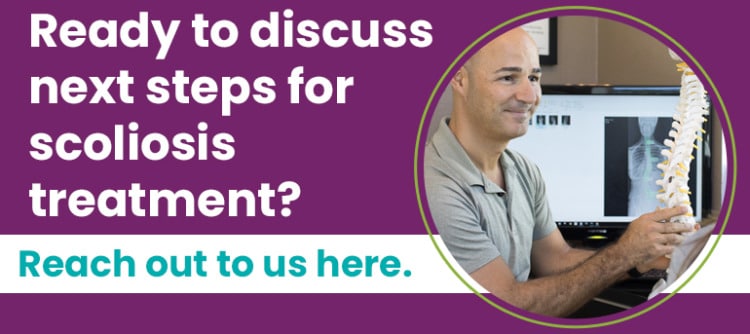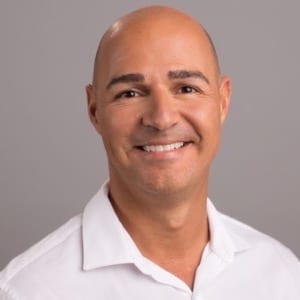What Is Scoliosis: An Introduction to a Confusing Condition
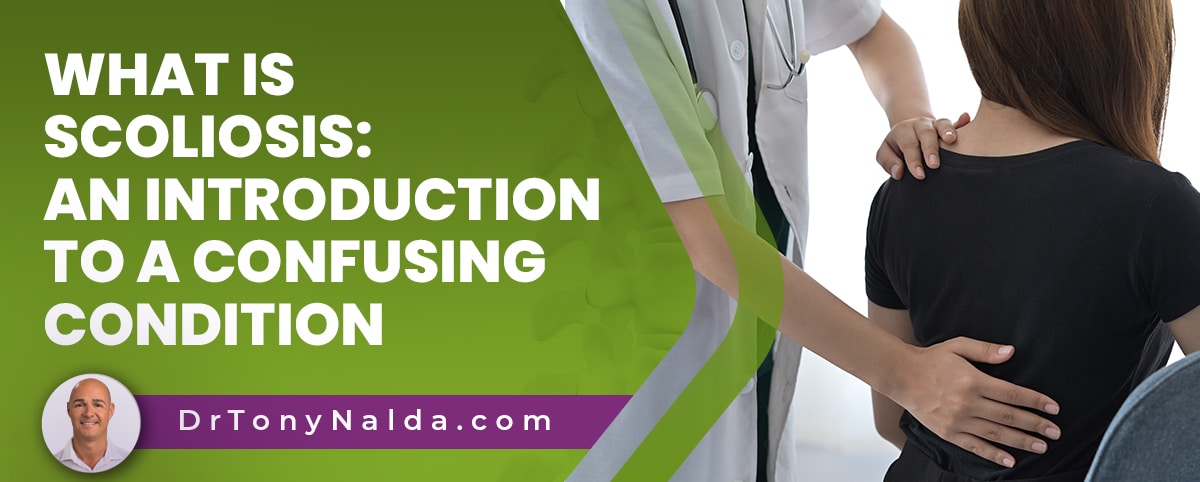
Scoliosis can be a complex condition to treat, and although it's been around for hundreds of years, we still don't know what causes its onset, in most cases. We do know that its progressive nature means it's likely to get worse over time.
Scoliosis is a spinal condition that causes the spine to curve unnaturally to the side and rotate, making it a 3-dimensional condition. An important characteristic of scoliosis to understand is the importance of early detection; patients also have different treatment options available.
Scoliosis can be described as complex or confusing, and this is often referencing its idiopathic and progressive nature.
Table of Contents
Most Cases of Scoliosis are Idiopathic
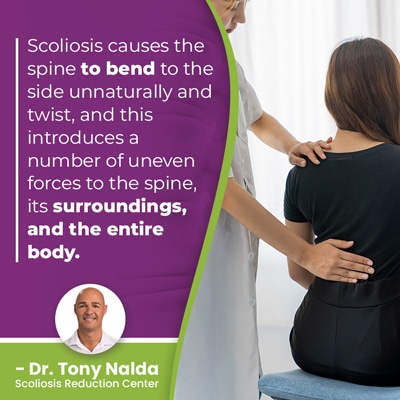 Scoliosis causes the spine to bend to the side unnaturally and twist, and this introduces a number of uneven forces to the spine, its surroundings, and the entire body.
Scoliosis causes the spine to bend to the side unnaturally and twist, and this introduces a number of uneven forces to the spine, its surroundings, and the entire body.
Idiopathic means not clearly associated with a single-known cause, and idiopathic scoliosis accounts for approximately 80 percent of known diagnosed scoliosis cases.
The remaining 20 percent are associated with known causes and an underlying pathology: neuromuscular scoliosis, degenerative scoliosis, and congenital scoliosis.
In cases of neuromuscular scoliosis, the presence of a larger neuromuscular condition like spina bifida, cerebral palsy, or muscular dystrophy causes the scoliosis to develop as a secondary complication.
Degenerative scoliosis affects older adults and is caused by natural age-related spinal degeneration.
Congenital scoliosis develops in utero due to a malformed spine, and these cases are rare, affecting approximately 1 in 10,000.
In atypical cases, curves can bend to the left, towards the heart, and this further complicates the condition and its treatment needs.
Idiopathic scoliosis is thought to be multifactorial: caused by a number of factors that can vary from patient to patient, and these cases are considered typical with scoliosis cures that bend to the right, away from the heart.
Although we don't know what causes the initial onset of most scoliosis cases, we know it's growth that makes it progress, which is why childhood scoliosis should always be taken seriously.
Scoliosis Progression
Scoliosis is progressive, meaning its nature is to become more severe over time, and this means the size and rotation of the unnatural spinal curve is increasing, as are its effects.
As scoliosis progresses, it's becoming more complex to treat as the spine becomes increasingly rigid, making it less responsive, and as condition effects are becoming more overt and established, they can be more difficult to improve and/or reverse.
The spine's healthy curves make it stronger, more flexible, and better able to handle stress during movement, so if an unnatural spinal curvature is increasing in size over time and with growth, it can disrupt the biomechanics of the entire spine.
The progressive path of scoliosis is from mild scoliosis to moderate scoliosis, severe and very severe scoliosis; these are the condition's severity levels.
But scoliosis can be highly treatable and progression can be managed proactively.
Progression in Children
So the more growth a patient has to go through prior to reaching skeletal maturity, the more potential progression there is.
Part of a young patient's diagnosis and assessment is looking at bone growth to determine a patient's likely level and rate of progression.
As progression is triggered by growth spurts, adolescent idiopathic scoliosis patients are the most at risk for rapid advancement, and this is the most common type of scoliosis.
Adolescent idiopathic scoliosis is diagnosed between the ages of 10 and 18 (or whenever skeletal maturity is reached).
Growth spurts trigger progression, and puberty involves rapid and unpredictable growth spurts, so a focus of adolescent idiopathic scoliosis treatment is on counteracting progression despite the constant trigger of growth occurring.
Progression in Adults
So if growth triggers progression, does this mean adults don't progress? Not exactly. There is also age-related spinal degeneration that can become a factor.
Degenerative scoliosis affects older adults and is caused by spinal degeneration that most often starts with the spinal discs degenerating, changing shape, and affecting the position of adjacent vertebrae attached.
Adults who have reached skeletal maturity don't tend to progress as quickly, but another factor that changes once skeletal maturity is reached is pain.
Scoliosis doesn't become a compressive condition until growth has stopped, and it's compression that causes the majority of condition-related pain.
Compression is uneven pressure and can involve muscle pain, back pain, and pain that radiates into the extremities due to nerve compression.
Radiating nerve pain is the main symptom of adult scoliosis that leads to assessment and diagnosis.
Early Detection
Idiopathic scoliosis is the most common type of scoliosis to affect adults, and this highlights the importance of early detection because these cases involve adolescent idiopathic scoliosis cases that weren't diagnosed or treated during adolescence.
It's a common scenario that adolescents with mild scoliosis don't notice its subtle symptoms, and as it's not commonly painful, it goes unnoticed until growth stops, compression starts, and pain signals something is wrong.
The reality is had these patients been diagnosed early and treated during adolescence, their spines would be far healthier and easier to treat.
Early detection means diagnosing scoliosis cases while mild, when they are the most likely to respond well to nonsurgical treatment. The curves are small, significant progression hasn't yet occurred, and condition effects aren't well established.
So the earlier treatment is started, the better, especially when it comes to childhood scoliosis.
Scoliosis Treatment Options
In addition to understanding the idiopathic and progressive nature of scoliosis, it's also important that patients are aware of all treatment options available to them.
Scoliosis treatment has two main approaches: surgical treatment or nonsurgical conservative treatment.
Surgical treatment is considered traditional, and while there are traditional bracing options, little is done to prevent progression, but when/if a patient becomes severe, spinal fusion is commonly recommended.
Spinal fusion surgery involves fusing the curve's most-tilted vertebrae into one solid bone to eliminate movement in the area, and metal rods may be attached to the spine to hold it in place.
The spine's natural design is based on movement, so straightening the spine surgically can mean a spine that's more rigid, painful, and weaker, so surgical intervention isn't always the best course of action.
Conservative Treatment
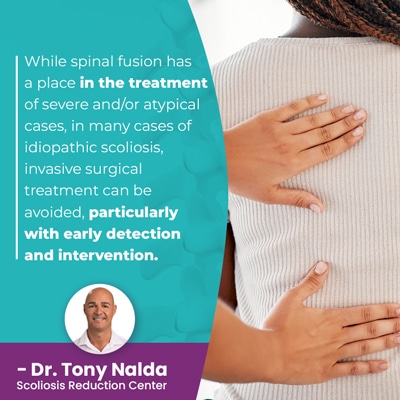 While spinal fusion has a place in the treatment of severe and/or atypical cases, in many cases of idiopathic scoliosis, invasive surgical treatment can be avoided, particularly with early detection and intervention.
While spinal fusion has a place in the treatment of severe and/or atypical cases, in many cases of idiopathic scoliosis, invasive surgical treatment can be avoided, particularly with early detection and intervention.
However, the benefits of early detection are only available to those who favor a conservative approach that's proactive; traditional treatment doesn't have a strategy in place for addressing scoliosis while mild so commonly recommends watching and waiting.
Watching and waiting can be dangerous, particularly for adolescents, because a significant growth spurt can trigger significant progression, making the condition more complex to treat.
The benefit of a proactive conservative approach is not only that it's integrative, combining the power of multiple treatment disciplines, but also because it works towards preventing progression.
Preventing progression can mean preventing increasing symptom severity and the need for invasive surgical intervention.
Conservative treatment combines the power of condition-specific chiropractic care, physical therapy, scoliosis-specific exercise, corrective bracing, and rehabilitation.
Conservative treatment won't recommend watching and waiting; this is wasting valuable treatment time.
Conservative treatment plans are 100-percent customized and started as close to the time of diagnosis as possible.
Conclusion
So why is scoliosis considered a complex and/or confusing condition? Because we still don't fully understand its causation, its nature is to get more severe over time, and there are multiple severity levels and condition types.
Even a scoliosis curve can vary in the direction of its bend, size, angle of rotation, and location within the spine.
No two cases of scoliosis are the same, which is why its complex nature necessitates the complete customization of effective treatment plans.
Here at the Scoliosis Reduction Center®, the goals of conservative treatment are to restore balance and stability to the spine and body, to reduce the curve size, improve posture, and sustain treatment results for the long term.
Chiropractic care, physical therapy, scoliosis exercise, corrective bracing, and rehabilitation can work together to ensure the underlying structural nature of scoliosis is impacted, along with improving the spine's surrounding muscle balance and strength for more spinal support.
The best time to start scoliosis treatment is always now, so don't hesitate to reach out for an assessment and support.
Dr. Tony Nalda
DOCTOR OF CHIROPRACTIC
After receiving an undergraduate degree in psychology and his Doctorate of Chiropractic from Life University, Dr. Nalda settled in Celebration, Florida and proceeded to build one of Central Florida’s most successful chiropractic clinics.
His experience with patients suffering from scoliosis, and the confusion and frustration they faced, led him to seek a specialty in scoliosis care. In 2006 he completed his Intensive Care Certification from CLEAR Institute, a leading scoliosis educational and certification center.
About Dr. Tony Nalda
 Ready to explore scoliosis treatment? Contact Us Now
Ready to explore scoliosis treatment? Contact Us Now